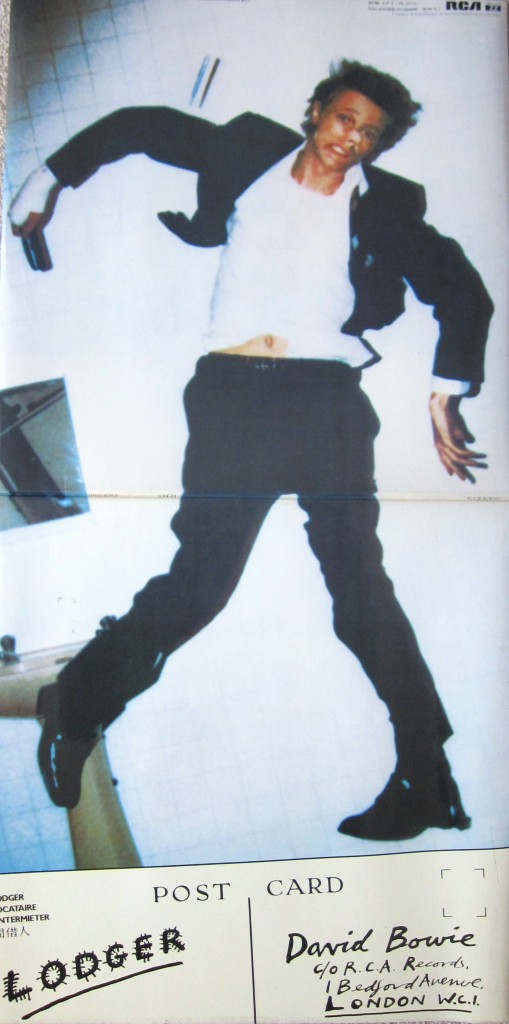David Bowie: a personal history
It was the spring of 1979. I was 17 years old and, since it was a Tuesday afternoon, in a record store. I was into Elvis Costello and Talking Heads and I was looking for other “New Wave” records to change my life. I saw, up on the shelf, Lodger, the new album by David Bowie, pictured above.
Look at that cover. That was the cover of an album by a major artist on a major label. I saw that cover and thought: “Huh. That’s weird. What the hell isthis?” To put the cover of Lodger into context, here are some other albums I might have seen in that record store that day: this, this, this, this, this, this, this, this and this.
The cover of Lodger was, in fact, so strange and mysterious that it spooked me a little. It was printed sideways and backwards, for one thing, with the image wrapping around the side of the gatefold, and the record top-heavy in the front pocket rather than weighing down the back. Everything about it was wrong, weird, fucked-up. I put David Bowie in my list of “artists to keep an eye on” and moved on to, probably, this.
A year or so later, David Bowie turned up, in Chicago (I was living in nearby Crystal Lake), performing in a run of the hit play The Elephant Man before taking over the title role on Broadway. As an aspiring 18-year-old playwright, I was primarily excited about seeing a genuine “Broadway play,” the fact that pop-star David Bowie was in the show was a secondary concern.
Well, the show was great, and Bowie was great in the part, and his first appearance on stage was as he appears in the second image above: naked but for a loincloth, his body way too thin and way too pale, as if the baby Jesus had been caught in a taffy-pull. I’ve been told that the part in The Elephant Man is “actor-proof,” but that didn’t detract from my enjoyment of Bowie’s performance as he mimed John Merrick’s illness and distorted his voice to approximate the sound of a man with a head full of bulbous bone growth.
So this David Bowie fellow suddenly became very interesting to me. And he had a new record out, Scary Monsters, which had a cover almost as weird and fucked-up as that of Lodger. I snapped it up at my local record boutique, took it home and dropped a needle on it.
Well.
The Buddhists say that when the student is ready, the teacher will appear, and Scary Monsters was exactly the record I needed to hear in the summer of 1980. At this point, I was living in a trailer in southern Illinois, in a neighborhood where, no kidding, an 18-year-old kid could get beaten up for listening to David Bowie. Or for listening to anything to the left of this.
Scary Monsters had everything: huge amounts of weirdness, oddly tuned guitars, plenty of jarring, unsettling effects, great passion juxtaposed with jaded disaffection. It was, yes, scary and super, monstrous and creepy.
The following three years involved me soaking up everything Bowie had done up to that point. He became the center of my musical universe — he went to Africa before David Byrne or Peter Gabriel did, he worked with Robert Fripp and Brian Eno before Talking Heads did and hired Adrian Belew before Talking Heads did too, for that matter. His records swerved all over the place from weird and arty to weird and poppy to weird and soulful to weird and blistering. I rarely believed a word he sang, but sincerity somehow seemed beside the point — underneath and alongside the layers of irony and pose, covered over and thrown into relief by incident and marketing, the “message” in Bowie somehow always was located somewhere outside the lyrics. Now, the day after his death, I’m finding more and more that Bowie’s distance isn’t as distant as I first thought — his lyrics are sometimes oblique and confounding, but just as often they are solid emotion wrapped in technique.
In the midst of my obsession, 1982, I acquired my very first cat. There was no question what he would be named: Bowie was my avatar, my polestar, the banner of my identity.

